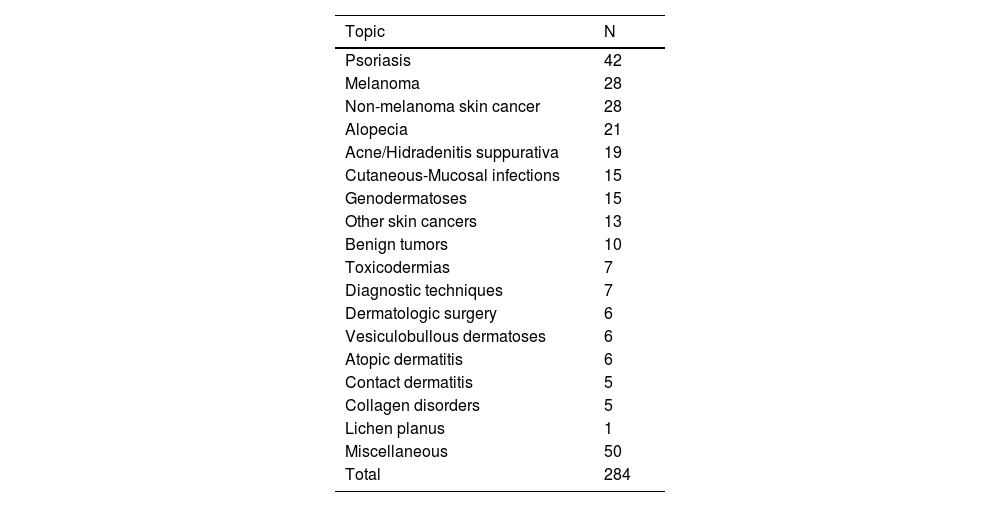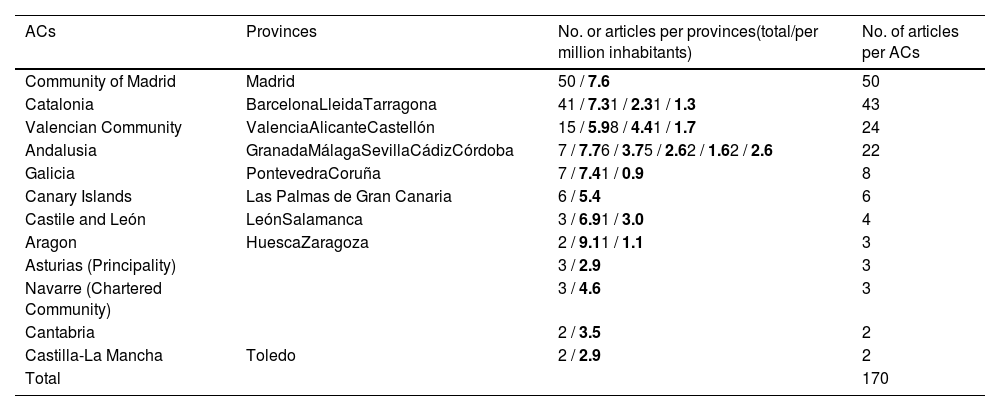Bibliometrics is a branch of scientometrics that analyzes the content of research papers published in scientific journals, considering certain bibliometric indicators.1 There are few bibliometric studies conducted by Spanish dermatologists,2-5 with heterogeneous designs in terms of the analyzed indicators and the intended objectives.
We describe below the data obtained from a retrospective and descriptive bibliometric study of the scientific production of Spanish dermatologists in the top 5 highest-impact factor (IF) journals from 2018 through 2019: Journal of the American Academy of Dermatology (JAAD), JAMA Dermatology, Journal of Investigative Dermatology, British Journal of Dermatology (BJD), and Journal of theEuropean Academy of Dermatology and Venereology (JEADV). This period was chosen to avoid biases associated with the SARS-CoV-2 pandemic such as too many articles on COVID-19, and interruption of clinical trials during the lockdown months. A bibliographic search was conducted using the PubMed database and crossing the keywords [SPAIN (affiliation)] AND [J Am Acad Dermatol OR JAMA Dermatol OR J Invest Dermatol OR Br J Dermatol OR, J Eur Acad Dermatol Venereol (journal)], and narrowing it down to the years 2018 and 2019. Figure 1 illustrates the flowchart.
A total of 284 articles met the inclusion criteria. A total of 138 of these articles were published in 2018 (48.6%), and 146 in 2019 (51.4%). The annual growth rate during the studied period was 5.8%. JEADV was the journal with the largest number of published articles, [107 articles (37.7% of the total)], followed by BJD and JAAD (table 1 and figure 1, supplementary data). The letters to the editor were the most frequent publications (113 articles, 39.8%), followed by original articles (97 articles, 34.2%), and case reports (23 articles, 8.1%). Reviews (4.6%), clinical practice guidelines or consensus documents (4.2%), article comments or editorials (4.2%), brief original articles (3.5%), systematic reviews (1.1%), and meta-analyses (0.4%) were the least numerous categories (figure 2, supplementary data). Psoriasis (42 articles, 14.8%), melanoma (28 articles, 9.9%), non-melanoma skin cancer (28 articles, 9.9%), trichology (21, 7.4%), and acne (19, 6.7%) were the main publication topics. Table 1 illustrates the research topics in order of frequency. Most studies were multicenter (187, 65.9%), with an annual growth rate from 2018 through 2019 of 20%. Among them, 119 articles (63.6%) involved international collaborations (Figures 3 and 4, supplementary data), and 57.4% of the articles published (163 articles) were multidisciplinary. Most studies were both multicenter and multidisciplinary (124 articles, 43.7%; table 2, supplementary data). In 196 articles (69%), the lead author was Spanish and affiliated with a dermatology center in 170 of the articles (59.9% of the total). Madrid (29.4%) and Catalonia (25.3%) were the regions with the highest production (table 2).
Research topics of the articles under scrutiny.
| Topic | N |
|---|---|
| Psoriasis | 42 |
| Melanoma | 28 |
| Non-melanoma skin cancer | 28 |
| Alopecia | 21 |
| Acne/Hidradenitis suppurativa | 19 |
| Cutaneous-Mucosal infections | 15 |
| Genodermatoses | 15 |
| Other skin cancers | 13 |
| Benign tumors | 10 |
| Toxicodermias | 7 |
| Diagnostic techniques | 7 |
| Dermatologic surgery | 6 |
| Vesiculobullous dermatoses | 6 |
| Atopic dermatitis | 6 |
| Contact dermatitis | 5 |
| Collagen disorders | 5 |
| Lichen planus | 1 |
| Miscellaneous | 50 |
| Total | 284 |
Data related to Autonomous Communities (ACs) and provinces listed in the affiliation data of the lead Spanish dermatologist author. In addition to the total no. of articles in absolute terms, we also analyzed the no. of publications per million inhabitants considering the population data for 2018 available on the National Institute of Statistics official website (www.ine.es); these data are highlighted in bold in the table.
| ACs | Provinces | No. or articles per provinces(total/per million inhabitants) | No. of articles per ACs |
|---|---|---|---|
| Community of Madrid | Madrid | 50 / 7.6 | 50 |
| Catalonia | BarcelonaLleidaTarragona | 41 / 7.31 / 2.31 / 1.3 | 43 |
| Valencian Community | ValenciaAlicanteCastellón | 15 / 5.98 / 4.41 / 1.7 | 24 |
| Andalusia | GranadaMálagaSevillaCádizCórdoba | 7 / 7.76 / 3.75 / 2.62 / 1.62 / 2.6 | 22 |
| Galicia | PontevedraCoruña | 7 / 7.41 / 0.9 | 8 |
| Canary Islands | Las Palmas de Gran Canaria | 6 / 5.4 | 6 |
| Castile and León | LeónSalamanca | 3 / 6.91 / 3.0 | 4 |
| Aragon | HuescaZaragoza | 2 / 9.11 / 1.1 | 3 |
| Asturias (Principality) | 3 / 2.9 | 3 | |
| Navarre (Chartered Community) | 3 / 4.6 | 3 | |
| Cantabria | 2 / 3.5 | 2 | |
| Castilla-La Mancha | Toledo | 2 / 2.9 | 2 |
| Total | 170 |
Belinchón and Ramos2 published a similar study to ours in 2008, in which they analyzed the Spanish scientific production published in international journals, regardless of their IF from 1997 through 2006. They could identify a total of 1018 articles, with a clear predominance of case reports (69.3%). In their bibliometric study on Spanish clinical research articles from 2005 through 2014, Molina-Leyva et al.4 concluded that most of this scientific production included case reports, few of them being the result of high-quality clinical research (level of evidence 5 in 93.4% of the 1104 included articles). As we focused on the top 5 journals with the highest IF, our findings are not directly comparable to those studies, and explain the high rate of original articles.
Psoriasis and melanoma were the most frequent topics of discussion in other studies as well.4-6 The emergence of new therapies and the study of comorbidities justify this rate. In our study, non-melanoma skin cancer was discussed in the same amount of articles as melanoma. Trichology ranks 3rd (7.4%), being scarcely represented in other studies.2,3
A striking finding from our study, not analyzed in others, is the high rate of multicenter studies (65.9%) (almost half [43.7%] were also multidisciplinary). These types of studies facilitate obtaining large sample sizes and improve the validity, quality, and scientific relevance of a research study. In recent years, these studies have been favored by improved communication through technological advances and probably by a change in the researchers’ mentality. Again, this is likely related to the quality of the publications studied.
Madrid and Barcelona are the provinces that lead scientific production, which is consistent with former studies.2,7
In conclusion, the scientific production of Spanish dermatologists in high-impact journals is significant. We saw a higher rate of original and multicenter articles compared to former studies.4,8 Nonetheless, further studies are needed to assess whether this was due to selecting journals with higher IF, or if is just a generalized trend.
Conflicts of interestNone declared.
We wish to thank Dr. Ignacio García Doval for his critical review of the manuscript










